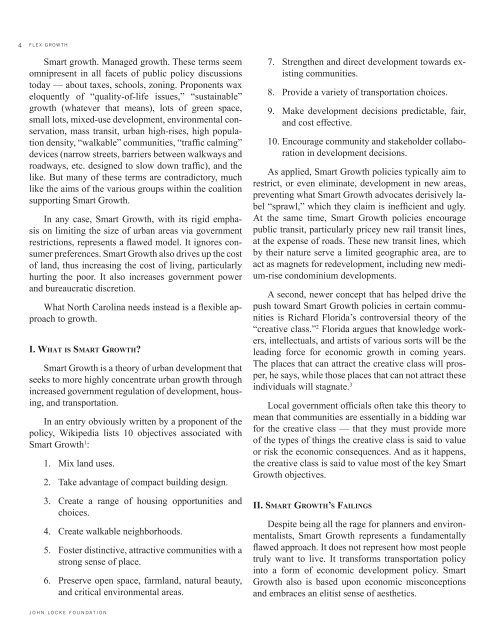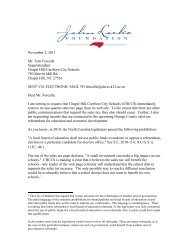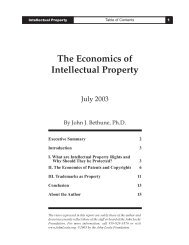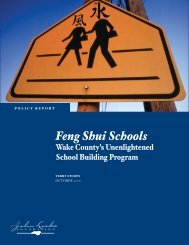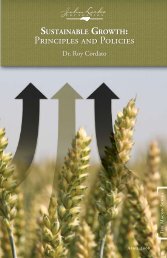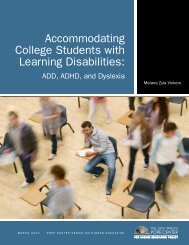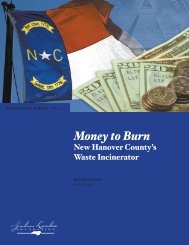Flex Growth - John Locke Foundation
Flex Growth - John Locke Foundation
Flex Growth - John Locke Foundation
Create successful ePaper yourself
Turn your PDF publications into a flip-book with our unique Google optimized e-Paper software.
4<br />
F L E X G R O W T H<br />
Smart growth. Managed growth. These terms seem<br />
omnipresent in all facets of public policy discussions<br />
today — about taxes, schools, zoning. Proponents wax<br />
eloquently of “quality-of-life issues,” “sustainable”<br />
growth (whatever that means), lots of green space,<br />
small lots, mixed-use development, environmental conservation,<br />
mass transit, urban high-rises, high population<br />
density, “walkable” communities, “traffic calming”<br />
devices (narrow streets, barriers between walkways and<br />
roadways, etc. designed to slow down traffic), and the<br />
like. But many of these terms are contradictory, much<br />
like the aims of the various groups within the coalition<br />
supporting Smart <strong>Growth</strong>.<br />
In any case, Smart <strong>Growth</strong>, with its rigid emphasis<br />
on limiting the size of urban areas via government<br />
restrictions, represents a flawed model. It ignores consumer<br />
preferences. Smart <strong>Growth</strong> also drives up the cost<br />
of land, thus increasing the cost of living, particularly<br />
hurting the poor. It also increases government power<br />
and bureaucratic discretion.<br />
What North Carolina needs instead is a flexible approach<br />
to growth.<br />
I. What is Smart <strong>Growth</strong>?<br />
Smart <strong>Growth</strong> is a theory of urban development that<br />
seeks to more highly concentrate urban growth through<br />
increased government regulation of development, housing,<br />
and transportation.<br />
In an entry obviously written by a proponent of the<br />
policy, Wikipedia lists 10 objectives associated with<br />
Smart <strong>Growth</strong> 1 :<br />
1. Mix land uses.<br />
2. Take advantage of compact building design.<br />
3. Create a range of housing opportunities and<br />
choices.<br />
4. Create walkable neighborhoods.<br />
5. Foster distinctive, attractive communities with a<br />
strong sense of place.<br />
6. Preserve open space, farmland, natural beauty,<br />
and critical environmental areas.<br />
7. Strengthen and direct development towards existing<br />
communities.<br />
8. Provide a variety of transportation choices.<br />
9. Make development decisions predictable, fair,<br />
and cost effective.<br />
10. Encourage community and stakeholder collaboration<br />
in development decisions.<br />
As applied, Smart <strong>Growth</strong> policies typically aim to<br />
restrict, or even eliminate, development in new areas,<br />
preventing what Smart <strong>Growth</strong> advocates derisively label<br />
“sprawl,” which they claim is inefficient and ugly.<br />
At the same time, Smart <strong>Growth</strong> policies encourage<br />
public transit, particularly pricey new rail transit lines,<br />
at the expense of roads. These new transit lines, which<br />
by their nature serve a limited geographic area, are to<br />
act as magnets for redevelopment, including new medium-rise<br />
condominium developments.<br />
A second, newer concept that has helped drive the<br />
push toward Smart <strong>Growth</strong> policies in certain communities<br />
is Richard Florida’s controversial theory of the<br />
“creative class.” 2 Florida argues that knowledge workers,<br />
intellectuals, and artists of various sorts will be the<br />
leading force for economic growth in coming years.<br />
The places that can attract the creative class will prosper,<br />
he says, while those places that can not attract these<br />
individuals will stagnate. 3<br />
Local government officials often take this theory to<br />
mean that communities are essentially in a bidding war<br />
for the creative class — that they must provide more<br />
of the types of things the creative class is said to value<br />
or risk the economic consequences. And as it happens,<br />
the creative class is said to value most of the key Smart<br />
<strong>Growth</strong> objectives.<br />
II. Smart <strong>Growth</strong>’s Failings<br />
Despite being all the rage for planners and environmentalists,<br />
Smart <strong>Growth</strong> represents a fundamentally<br />
flawed approach. It does not represent how most people<br />
truly want to live. It transforms transportation policy<br />
into a form of economic development policy. Smart<br />
<strong>Growth</strong> also is based upon economic misconceptions<br />
and embraces an elitist sense of aesthetics.<br />
J O H N L O C K E F O U N D A T I O N


